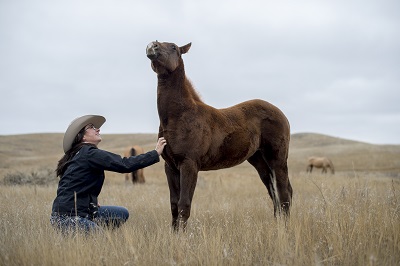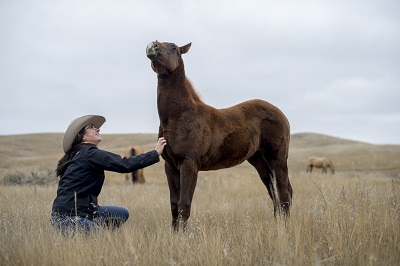Native American producers have prolonged been not famous of the agricultural dialog. Now that regenerative agriculture is trending, these growers current that caring for full ecosystems isn’t a model new thought, it’s deeply standard.
Jessika Greendeer says the vital factor to farming is getting alongside collectively together with her coworkers. She’s not talking about people. She means the animals, the residing soils, and the vegetation that coexist on the land she works. As a farmer, she doesn’t see herself as accountable for the land, merely as a steward of it. The best way through which she manages her farm—regenerative agriculture—is gaining popularity, nonetheless for Greendeer and totally different Native Folks, its practices are standard.
Greendeer, who’s a Ho-Chunk Nation tribal member from Baraboo, Wisconsin, presently works as a farm supervisor and seed-keeper on the Native-led Dream of Wild Effectively being Farm in Minneapolis, Minnesota, and grows in her micro-farm in Hudson, Wisconsin, named “Little Sky’s Farm.” Though Greendeer makes use of the phrase “regenerative” when describing her farming practices, she and totally different Native growers are using it as a buzzword whereas practising farming from an Indigenous perspective. That perspective comes from a historic previous of not using heavy gear and the individuals inside the system acknowledge they’re stewards, not controllers, of the land.
The regenerative agriculture movement has been rising shortly for just a few decade as scientists realized soil properly being is essential to native climate change mitigation. Nonetheless native climate change has been largely perpetuated by the wasteful emissions of white Westerners, with the US historically creating basically essentially the most emissions on the planet, no matter making up solely about 4 % of the world’s inhabitants.
Decolonizing Regenerative Agriculture Means Along with All Beings
Within the an identical method white people received right here to North America and seized administration of the land, forcing Indigenous people to assimilate or die, colonization moreover affected agriculture practices.
The opposite of regenerative agriculture is typical agriculture—which entails fields of only one crop, spraying pesticides, and separating animals into crowded feed heaps. These circumstances grew to change into the norm with the industrialization of agriculture—which occurred in waves, the first when humankind shifted from hunter-gatherers to agricultural society, the second via the mechanization of agriculture, and the third via the “inexperienced revolution” of the Fifties and 60s when chemical pesticides and fertilizers had been launched.
Every revolution, along with the fourth and current wave of regenerative agriculture, has not famous Indigenous communities, primarily based on A-dae Romero-Briones (Cochiti/Kiowa), the director of purposes for Native agriculture and meals methods on the First Nations Progress Institute.
Decolonizing regenerative agriculture means recognizing and restoring Indigenous meals practices, which focus on the properly being of the entire ecosystem, instead of using regenerative practices to mitigate unfavourable outcomes of typical agriculture.
“We’re anticipating a number of our producers, nonetheless we’re forgetting that our producers are a part of the system. Nature reveals us that the additional stress an animal or a being experiences in a system, the a lot much less means they need to battle off these exterior pressures whether or not or not it is sickness, or on this case after we’re talking about individuals; despair, suicide, foreclosures, or chapter,” says Kelsey Ducheneaux-Scott (Itazipco Lakota of the Cheyenne River Sioux Tribe), who’s a regenerative rancher and the director of purposes on the Intertribal Agriculture Council. “These are all points that the majority producers in our enterprise presently are coping with and that’s an indication of the system not being healthful.”
Romero-Briones explains that agriculture was used to suppress and “civilize” Native people, because of Indigenous people had their very personal method of stewarding their lands. These practices included stewarding bison for Native Nations inside the Good Plains, and planting seeds alongside typically traveled routes for various nomadic tribes, to have the flexibility to reap upon returning months or years later. There could also be moreover a superb reliance and reverence for versatile and hardy species of corn, beans, and squash. Nonetheless in some unspecified time sooner or later, the methods blended, which she explains as “syncretism,” an amalgamation of two numerous issues that grow to be better than the sum of their parts.
“There’s so many Indigenous individuals who discover themselves every practising Indigenous identification and agriculture, nonetheless creating these full new strategies of current, rising, and producing meals. That’s truly pretty dynamic,” says Romero-Briones. “And that’s the idea behind irrespective of I’m hoping ‘regenerative agriculture’ will grow to be.”

Meals Sovereignty and the Pandemic
Sovereignty means having your private power to govern—Native Folks have been advocating for sovereignty of their very personal people as a result of it was taken from them by colonists and the US authorities.
Meals sovereignty is one different goal of many Native Folks. Whereas Native people fed themselves for tons of of years sooner than the US was colonized, as a consequence of genocide, displacement, and continued lack of financial assist, Native foodways have been suppressed. This means Native people residing on reservations or in metropolis communities too often experience meals insecurity or meals apartheid.
True regenerative farming enhances meals sovereignty because of it gives once more to the an identical communities it makes use of sources from, primarily based on Ducheneaux-Scott, who owns DX Beef, located on the Cheyenne River Sioux Reservation in South Dakota.
Firstly of the US covid-19 outbreak, even when there had been no reported circumstances of covid-19 in South Dakota, grocery retailer cupboards on the reservation had been already empty as a consequence of reliance on grocery retailer gadgets being shipped largely from the coasts. Completely different grocers, off the reservation, nonetheless had meals on the cupboards in the mean time, Ducheneaux-Scott says.
For meals sovereignty to exist on the reservation in South Dakota, Ducheneaux-Scott says, it may take farmers who want to educate along with purchasers who want to research, or who already know, the benefits of purchasing for native regenerative meals.
“I can exploit that I’ve a Native-owned, female-owned meals enterprise and I shall be exporting 100% of my product to the cities and be making thrice what current beef prices regionally are, because of there’s demand from that educated shopper group,” says Ducheneaux-Scott. “Nonetheless is that mainly being regenerative and giving once more to my space individuals whose sources I am using with a view to derive this income or is it exploiting it merely the an identical as our typical row crop manufacturing?”
For that motive, she sells 90 % of DX Beef merchandise on the reservation, nonetheless says purchasers are typically pressured to buy what has the longest shelf life because of entry to native and up to date meals is restricted.
“I actually really feel like as a regenerative operator, I’m contributing to enhancing entry to native healthful, top quality meals to the individuals of the system that I work to serve.”
Setting up Sources from the Flooring, Up
In Portland, Oregon, Roberta Eaglehorse-Ortiz (Oglala Lakota/Yomba Shoshone) observed a proposal to utilize a small outside home owned by the Portland Meals Monetary establishment and developed the idea of a yard teeming with standard and medicinal vegetation. Though she had no gardening experience, as a doula and lactation specialist who had directed the Oregon Inter-Tribal Breastfeeding Coalition, she was eager to assemble sources for Indigenous households inside the house. Portland is dwelling to over 50,000 Native American people on account of Oregon reservation lands being “terminated” by Congress inside the Fifties.
Since its start in 2015, the Wombyn’s Wellness Yard is prospering with every kind of assorted vegetation and with the help of group volunteers and faculty college students from Oregon State Faculty. Breastfeeding assist for Native communities will also be related to the movement for meals sovereignty.
“Our first meals is breast milk for all human infants. That’s what we might like,” says Eaglehorse-Ortiz. “We moreover should nourish the households to develop healthful infants to have healthful restoration. And what larger meals is that then standard meals, Native meals? So that’s what guided me there. After which the seeds merely started coming.”
Passing on Seeds and Practices
Seeds are notably important to Indigenous people as an emblem of life. A-dae Romero-Briones explains that seeds are revered—because of full civilizations trusted a single crop, like corn, for lots of Native nations on the North and South American continents.
In enterprise agriculture, seeds are a commodity which may be manipulated, and they also have higher value when made infertile, she explains.
“[Commercial seed] has basically essentially the most value when it’s infertile and shall be completely managed by man,” says Romero-Briones. “That must be the prime occasion of the two fully totally different views on meals. You can’t commodify this [seed], the giver of life. Nonetheless in [industrial] agriculture, each factor is commodified, which sucks the life out of your complete system.”
Eaglehorse-Ortiz and Greendeer even have inherited or been gifted seeds, and folks seeds operate a connection to earlier generations.
“What motivates me simply is not solely reconnecting with my ancestral seeds, however moreover serving to totally different people do the an identical. The whole thing that I do develop, I’ve been gifted, or I’ve a relationship with it,” says Greendeer. “It’s not solely a winter squash, it’s this tribal squash with this form of story. It’s not merely an merchandise, nonetheless it’s additional, it’s one factor that we’re capable of all get deeply linked to.”
“You can’t commodify this [seed], the giver of life. Nonetheless in [industrial] agriculture, each factor is commodified, which sucks the life out of your complete system.” —A-dae Romero-Briones, First Nations Progress Institute
Apply Decolonizing to Your Life:
Discover out about whose land you’re on. For individuals who’re a US reader, most definitely you’re on the land of a lot of tribes who stewarded the soil, vegetation, and animals sooner than that they had been violently pushed out by colonists and settlers. Discover out about whose land you’re on at native-land.ca.
Help Native growers. After determining whose land you’re on, uncover Native communities which is perhaps seemingly nonetheless there tending to the Earth. Help native Indigenous growers by trying to find them out or purchasing for from them on the farmer’s market. It’s possible you’ll as properly uncover a nationwide map of Native producers inside the American Indian Meals Program.
Discover out about your private meals historic previous. Greendeer emphasizes that with so many enterprise crops, we’re all extra more likely to be far from the seeds that nourished our ancestors. She recommends doing just a little evaluation on what your grandmother’s grandmother may have eaten and to hunt out these seeds and develop them. “Make sure future generations shall be nourished by the an identical meals,” she says.
